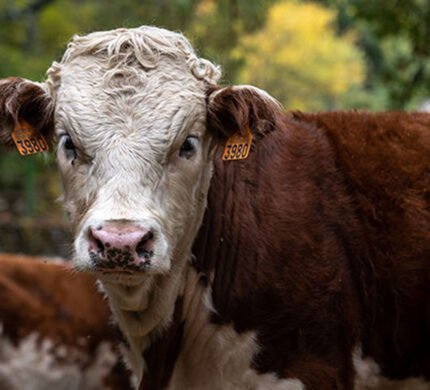Hereford cattle
- Temprature:10°C and 20°C (50°F and 68°F)
- Milk:Not raised for milk production
- Food:Plant material
- Pregnancy:Around 285 days
- Nationality:United Kingdom

General Information
Hereford cattle are a breed of beef cattle that are known for their distinctive red and white color pattern. They were originally developed in the county of Herefordshire in England, and are now one of the most widely used beef cattle breeds in the world. Herefords are hardy, adaptable animals that can thrive in a variety of environments, which has contributed to their popularity and widespread use.
Herefords are known for their high-quality beef, which is prized for its tenderness, flavor, and marbling. They have a calm and docile disposition, which makes them well-suited for both feedlot and range production systems. Herefords are also known for their fertility, mothering ability, and longevity, which makes them a popular choice for many ranchers and beef producers.
In a feedlot setting, they may be fed a more concentrated diet that includes additional grains, protein supplements, and other feedstuffs to meet their nutritional needs and support their growth and development.
Overall, Hereford cattle are a versatile and highly valued breed that are an important part of the beef industry. Whether raised on pasture or in a feedlot, Herefords are known for their high-quality beef and their ability to adapt to a variety of conditions, making them a popular choice for many beef producers around the world.
In terms of diet, Herefords are herbivores and feed primarily on forages, such as grasses, hay, and silage, as well as energy-rich grains, such as corn and barley.
Where we find this cow to buy?
Before you buy Hereford cattle, it’s a good idea to do your research and make sure you’re buying animals that are in good health and have the right genetics for your specific needs. You may also want to consider working with a veterinarian or animal nutritionist to develop a care and feeding plan for your new cattle.
01. Livestock auctions: Auctions regularly sell Hereford cattle as individual animals or in groups. This is a good option if you're looking for a wide selection of animals to choose from.02. Breeder associations: The American Hereford Association and Canadian Hereford Association keep lists of Hereford cattle breeders. Additionally, they can help you find local breeders.03. Online marketplaces: Online marketplaces, such as Ranch World Ads and Cattle Exchange, offer listings of Hereford cattle for sale from breeders and producers around the country.04. Ranchers and farmers: You can also reach out to local ranchers and farmers in your area who raise Hereford cattle to inquire about the availability of animals for sale.

How to increase milk production in Hereford cattle
Hereford cattle are primarily used for beef production, rather than dairy production. As a result, increasing milk production in Hereford cattle is not a common goal. Hereford cows have a relatively low milk yield compared to dairy breeds, and their milk is also lower in butterfat and protein. However, if you are interested in using Hereford cattle for dairy purposes, there are some steps you can take to try to increase their milk production:
Hereford cattle need a balanced diet to thrive. Nutrition is essential for cows. Optimum nutrition for milk production can increase milk yields.
Regular veterinary care, including vaccination and parasite control, can help maintain the health of Hereford cattle and improve their milk production.
A good milk production genetic can help increase milk yields in Hereford cattle. Keep accurate records of your cows’ milk production to track their progress.
Milk production can be increased by providing cows with proper space, ventilation, and bedding. A cool environment in hot weather can also improve the health and productivity of cows.
Medicine
It’s important to note that medications should only be used under the guidance of a veterinarian, and the specific medication used will depend on the individual needs of the animal and the specific condition being treated. Improper use of medications can be harmful to the animal and can also contribute to the development of antibiotic-resistant bacteria.
Hereford cattle, like all livestock, may require veterinary care at various times during their lives to prevent or treat diseases and conditions. Here are some common medications that may be used to treat Hereford cattle:
01
AntibioticsAntibiotics may be used to treat bacterial infections, such as mastitis, respiratory infections, and gut infections.
02
Anti-inflammatory DrugsThere is no doubt that NSAIDs are useful in treating arthritis, lameness, and musculoskeletal pain.
03
ParasiticidesParasiticides may be used to control internal and external parasites, such as worms, flies, and ticks.
04
VaccinesA vaccine can prevent or control diseases such as bovine respiratory disease and bovine viral diarrhea.

- Hereford cattle are herbivores, which means that they feed primarily on plant material. In the wild, they would feed on a variety of grasses and other vegetation. However, in a managed agricultural setting, Herefords are typically fed a balanced diet that includes a variety of different feedstuffs, such as hay, silage, grains, and by-products of other agricultural industries, such as brewers' grains and distillers' dried grains.
- A Hereford's diet will differ depending on several factors, including their age, their weight, and the availability of feedstuffs local to them. Herefords generally require a wide variety of forages, including hay, silage, corn, beans, as well as energy-rich grains. The diet may also include protein-rich supplements, such as soybean meal, to help meet the cows' nutritional needs.
Important!
It’s important to note that Herefords have a moderate to high nutritional requirement, depending on their stage of production and other factors. Providing a balanced and adequate diet is essential for their health and productivity. This may involve working with a veterinarian or animal nutritionist to develop a diet plan that meets the specific needs of your herd.
Pregnancy
In Hereford cattle, pregnancy typically lasts for around 285 days, or just under 9 and a half months. During this time, the cow’s body undergoes a number of changes to support the growth and development of the fetus.
During the first few weeks of pregnancy, the fetus is forming and growing rapidly. The placenta is also developing, which is essential for transferring nutrients and oxygen from the cow to the fetus.
During the middle stage of pregnancy, the fetus continues to grow and develop, and the cow may start to show signs of her pregnancy, such as a noticeable increase in size or changes in her behavior.
In the late stages of pregnancy, the cow will start to prepare for birth, and her udder will begin to develop in preparation for milking. Be prepared to assist with the birth if necessary during this time.
Facts
There are many Hereford cattle that can produce calves for a long time, sometimes up to fifteen years.
Bulls and cows of Hereford cattle are medium to large in size, weighing between 1,500 and 2,000 pounds.
The genetic diversity of cattle breeds relies on hereford cattle genetics, which are part of a conservation program.
The Hereford cattle thrive in a wide variety of climates and environments, including hot and cold conditions.
Hereford cattle produce high-quality, flavorful, tender, and juicy beef. Both commercial beef and grass-fed beef are produced with them.
A Hereford breed of cattle originated in the county of Herefordshire in England, and was first imported to the United States in the early 1800’s.
Hereford cattle are generally docile and easy to handle, making them a popular choice for beef production and as rodeo cattle.
Crossbreeding programs use Hereford cattle to improve the hardiness, efficiency, and carcass quality of other cattle breeds.
It’s important to note that medications should only be used under the guidance of a veterinarian, and the specific medication used will depend on the individual needs of the animal and the specific condition being treated. Improper use of medications can be harmful to the animal and can also contribute to the development of antibiotic-resistant bacteria.